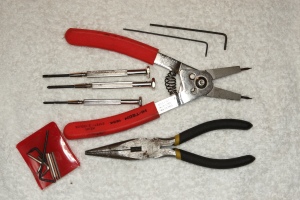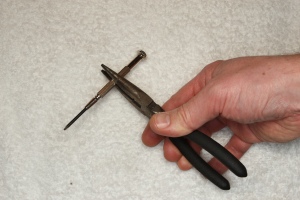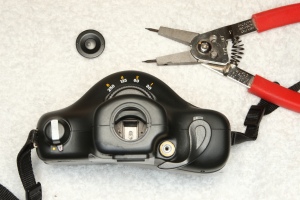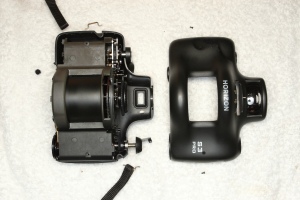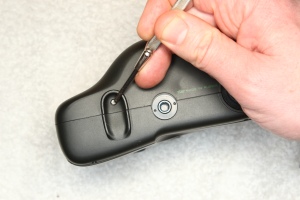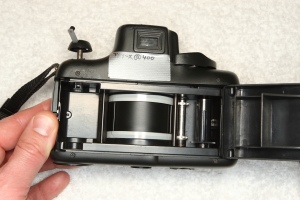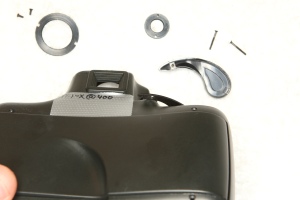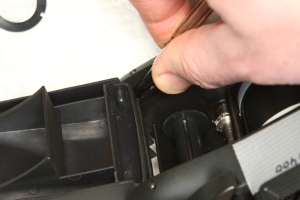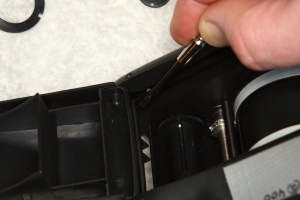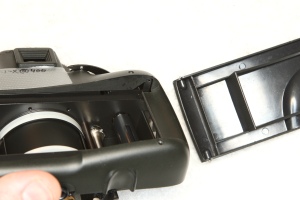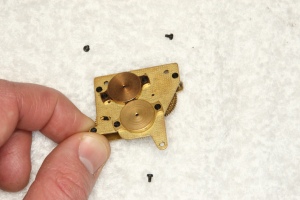The first thing I’ll say is this: do not, under any circumstances, put the bike into first gear and start the engine. Just don’t do it.
For some reason people get fixated on the chain running under the scrubbing brush and think that this is a good idea. I’ve done it. Most bikers have at some point or other, and then we have a near miss and rapidly learn to never do it again. In my case the brush got yanked out of my hand. I wasn’t holding a rag onto the chain, and I was lucky. A lot of people lose tips or joints off their fingers or thumbs. Some people lose their hands. I’ll say it again: never run the engine while you’re cleaning the chain. Run the chain by turning the back wheel by hand.
I tried a few different methods over the years, with varying results:
- Taking the chain off the bike, immersing in kerosene, and scrubbing with a dish brush. I scrubbed the sprockets as well. Brilliant results but it’s hard work.
- Buying a cheap fluffy bath towel and scrubbing by hand, wearing gloves and soaking the towel in kerosine. It did a fantastic job on the outside of the chain but didn’t touch the areas inside the links. Also hard work.
- Using a clip-on driven brush scrubbing machine, made by Muc-Off, with their proprietary degreaser. Horribly expensive, with indifferent results and toxic chemistry everywhere. The brush machine was badly designed and didn’t touch the flanks or insides of the chain. Of course it did little or nothing for the caked-on gunk on the sprockets. This experience was so disappointing that I’ve never bought Muc-Off again.
- Scrubbing the chain on the bike, with kerosine, an old dish brush and a stainless steel bowl to catch run-off. Hard work, the outside of the chain and the rear sprocket cleaned up beautifully, the inside faces of the chain links were hard to get to, and the front sprocket couldn’t be cleaned. I also had to wipe kero and sprayed dirt off frame, tyre, wheel rim and bodywork afterwards.
There is an odd-looking brush that you can buy – it features two sets of bristles set at 90 degrees, facing each other. It’s ridiculously expensive for what it is. I couldn’t see this being any better than anything else I’d tried, since I already knew that brushing tends to spray dirt, oil and solvent all over the rest of the bike.
I spent a while thinking about this and then trialled a different idea – spraying kerosene onto the chain and rear sprocket via a car’s windshield washer pumps and nozzles, with a shroud to catch overspray. The unit would be positioned on a car’s scissor jack. I built a rough prototype and tried it.
It took a while to get it ready and it didn’t work. The chain and sprocket kept jamming in the shroud, the jets were impossible to aim, and I got kero over everything. But that’s prototyping – this kind of thing is progress, it just doesn’t feel like it. I sat down, had a think, and realised that the jets actually did work. The answer was to go low-tech and simple instead of building a dedicated machine. What mattered was the method, not the hardware.
So I tried this: garden spray bottles and a tray under the rear wheel. No brushes, no scrubbing, I agitated the dirt using only the jets from the bottles. No kero either: I went with citrus-based degreaser, something that could be ethically disposed of in my laundry sink. I sat at the back of the bike, turned the rear wheel by hand with the bike up on a centerstand, and sprayed degreaser onto sprocket, hub, chain, swingarm and chainguard. I waited the recommended time and then used a pump-up watering bottle to wash the bike down again, getting the jets into everything both times. The tray caught the bulk of the run-off. I towelled up the rest. I then dried the bike off by putting it out into the sunlight and fresh air (use a dehumidifier if you’ve had to do this at night) before re-lubing the chain.
Total working time was about an hour, but I went over the chain several times with the degreaser-rinse cycle. The old lubricant had done the thing where it had aged and turned into tar. If I did this regularly (i.e. once a month or so) then I can see this getting to the point where it’s half an hour or less, with only one degrease and rinse cycle needed. This could be done as part of a regular bike wash, with one hose rinse afterwards for everything.
The spray method also means that it’s possible to clean out the front sprocket. Take the cover off, gouge out the worst of the clumped dirt with a screwdriver, and have at it. I’d recommend using kero for the first time you do this (the rest of the chain and rear sprocket included) since it really does take the tar-gunk off, but once you’re into regular cleaning cycles then water soluble solvents should get the job done without problems.
A quick note on solvents: the reason I used kerosene is because kero leaves a thin oil film, is a lubricant in its own right, and doesn’t attack rubber. Turpentine is a more aggressive degreaser but can attack rubber, possibly cracking the O-rings.
A mate’s bike had an O-ring on the chain break and fall off. I hadn’t realised this before, but the little rubber rings function as mechanical spacers. Without that O-ring, the chain developed a kink and then started hitting the sprockets with the side plates on the affected roller. It rapidly wore into the kinked position and got to the point where I thought it was going to bind and then snap. Very dodgy. The whole lot then had to be replaced… granted, it probably wasn’t cleaned at all, let alone with turps, but it shows that it’s worth looking after those little rubber seals.
The degreasers developed for bicycles are similar in regards to their not damaging anything. The (western, first world) cycle crowd these days are monied, fussy and very well connected via the internet. There’s a lot of passion going around. Technical advancements have been rapid. The most sophisticated cleaning products are therefore found in bicycle shops, not in automotive places. Any product that hurt tyres, bearing seals or paint would rapidly be damned via the internet and then disappear from the marketplace.
It is possible to buy very active degreasers from auto shops. The idea is simple enough, you spray them on, with cardboard or newspaper underneath to collect the runoff, then wrap the paper up and chuck the stinking mess into the bin. I don’t like them. Fumes, fire risk, and ecological impacts are all unacceptable as far as I’m concerned. I also don’t like the way that they get dirt moving only for as long as they don’t evaporate. Anything that doesn’t drop off just ends up being deposited back on again. I will say that they do work on really thick collections of oil-caked muck, but then if the vehicle was cleaned regularly, this wouldn’t be a problem anyway.
Scrubbing with a brush is also something I’m trying to move away from. I believe that it’s popular because it yields results while you work – you can see what your effort is doing. The problem with it is that if your brush can’t reach it then you can’t scrub it. You can also end up pushing dirt into crevices, like chain o-rings, for example.
The jets get into corners, don’t tear up the chain seals, and carry dirt away. The bottles were about five dollars each and store easily, even with solvent still in them. The best bit of the job was finding my chain dry and unrusted in the morning, with an ideally thin film of lubricant still present. The method worked. The next thing I’ll try doing is finding a method to relubricate the chain, but without the excess lube that spraying straight from the can tends to leave.

